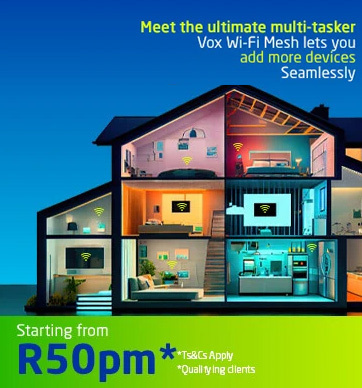We know how it goes.
You’ve finally decided to sign with Vox. After all that head scratching and Googling, waiting for responses to your Facebook status and scrolling through Twitter, you’ve made up your mind and you’re ready to join our family.
At this point, everyone’s happy. You’ve checked the boxes online, submitted the forms, spoken to our (admittedly rather lovely) sales agents and you’re ready to go. Imagine your surprise, then, when you’re not instantly connected?
What gives? Where’s the little green fairy that gets my browser going? I had plans of the Office, FIFA Tournaments and and a weekend of Netflix in bed, but I’m not online yet?
We get it.
The only thing worse than not having Internet (and load shedding) is having Internet that isn’t working right now.
Gone are the days of simple distractions. Everything from our phones to our TV’s to our 9 – 5 work time is now dependent on being online.
What many people don’t realise, however, is the incredible amount of work behind the scenes that goes into making sure your connectivity happens. It’s not as simple as turning on a switch and waiting for an astronaut to connect a wire, nor is it as easy as plug-and-play. Fibre is our pride and joy because it works, but the reality is that getting it off the ground can take time. So, before you start attacking your keyboard and throwing more shade than an umbrella store on Black Friday, here’s our guide to surviving the wait for Fibre (as well as possible reasons for any delays).
Step One: It’s in the Deets.
The first point of contact when signing up for FTTH is the equivalent of a first date. We can’t help you if we don’t know you, so we need to start by finding out your information (because we get catfished too. Don’t ask, you’d be surprised).
This immediately leaves room for delays because, as much as we’d love to be fully automated, parts of this process rely on human engagement (we knew we should have invested in robots). Be it reliance on the client to provide the info or on a physical salesperson to process the order, at least two people are involved in the early steps – meaning there’s room for a bit of lag on either side.
We also have to proceed with contract vetting and assessing whether there’s an existing line on any registered address. Stay with us, because this is where it gets slower than Gilloolies on a Friday (and clogs our Twitter feed just as much).
If there’s an active connection on an existing line , we must ensure that this is removed before we can do our thing. It’s not that we want to take our time, but new tenants can’t start unpacking their belongings while the previous tenant is having an afternoon nap. Most ISP’s have a cancellation notice period before the line is inactive (ours is a clear calendar month), which means there’s already room for delay in the first stage of the process. Yay?
Step Two: It’s not me, it’s you.
Remember what we said about being catfished? Step Two is designed to counter that.
Herein, we proceed with the RICA approval and certification of our new applicants. We need to ensure that you’re a real person (and who you say you are) because, let’s face it, the Internet can be crazy. Herein, we validate your information AND ID copy against a Home Affairs Database (and, thankfully, our process doesn’t require gum chewing employees saying “the system is currently offline”).
If you’re like us and you took your ID photo when your hairline was still within the same hemisphere as the rest of your face, don’t stress, most times any failures we get are a quick fix with some human intervention. Again, there are two checks, meaning two points of failure – this is another vetting stage of the process which can (and sometimes does), take time.
Step Three: PMO, FNO, L-M-N-O…
This isn’t really a delay stage, but more us verifying the order and making sure the Fibre line is going to the right place. We need to factor in your street address, unit number, and all the nitty-gritty stuff that nobody wants to read in a blog, so we’re going to move to the next point.
Step Four: Line Me Up, Scotty.
Herewith the bearer of bad news and destroyer of moods, installing your actual Fibre line. Okay, some (or most) areas don’t require us to come in and destroy your rosebushes, in which case you should be good without the hassle. For those who need our technicians to do their thing so you can do yours, however, this presents its own share of potential delays.
Firstly, the actual installation depends on availability and a convenient time for both parties. Then there’s the actual digging, the installing and making sure everything is up and running. Sometimes, clients want the technicians to take a less disruptive route around the newly laid lawn which could lead to an additional once off charge, and this invoicing step can add delays . In simple English, installing a line isn’t fun – and everyone knows that anything that isn’t fun takes the longest. Like an episode of Bridgerton.
Step Six: Don’t Call Me, Maybe.
A big component of getting you going is actually getting hold of you. It may sound simplistic, but you’d really be surprised. Some steps of the process can’t move to the next level without us speaking to our newest family member. These include finding out availability, arranging for the Router to be delivered, installation suitability and running a test once everything is set up to ensure you’re really connected.
Some people don’t answer numbers they don’t know, others have us listed in Truecaller as “big Green scammer”, while some are just notoriously tricky to get in touch with. We get it, we’ve spent a fair amount of time convincing call centre agents we’ve moved to Tokyo, but when it comes to Fibre, we don’t call for fun.
All-in-all, there are a plethora of reasons your connectivity can be taking a little bit longer than expected. Now, we’re not saying ignore it until we’re ready for you, but sometimes things can take a while to get running.
However, you know how they say, “good things come to those who wait”?
They were talking about Vox Fibre when they said it.













